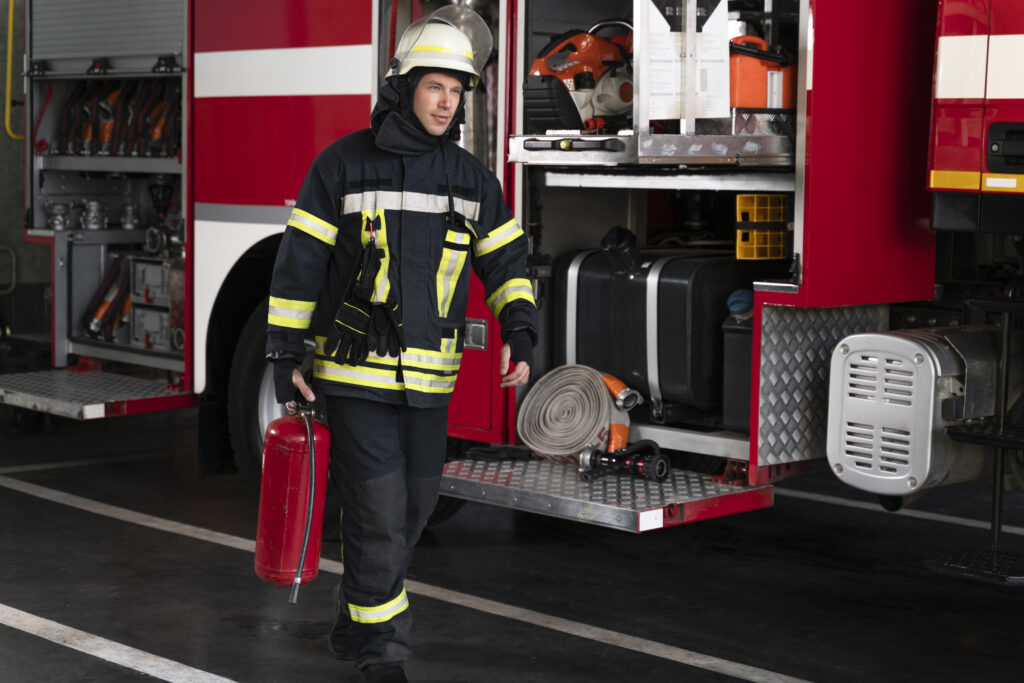Fire Fighting Equipment
Firefighting equipment is a critical component of fire safety measures designed to detect, control, and suppress fires in various environments, ranging from residential buildings to industrial facilities. These systems and devices are strategically deployed to prevent the spread of fires, protect lives, and minimize property damage. Key firefighting equipment includes fire extinguishers, fire alarm systems, sprinkler systems, hydrants, fire pumps, clean agent fire suppression systems, and other specialized fire suppression systems. Together, these tools form a comprehensive fire protection system that plays a crucial role in safeguarding people and property.
Inspection and Testing Services are provided for following equipment:
- Fire Extinguishers
- Fire Alarm System
- Sprinkler System
- Hydrants
- Fire pumps
- Clean agent fire suppression systems
- Fire suppression systems
- Fire Fighting Truck

Regular inspection and testing of fire fighting equipment are crucial components of a comprehensive fire safety program. These practices ensure that the equipment is in optimal working condition, ready to respond effectively in the event of a fire. The benefits of inspection and testing include:
Key Services
Inspection and testing verify the reliability of fire fighting equipment, such as fire extinguishers, ensuring that they will function as intended when needed. This builds confidence in the effectiveness of the overall fire safety system.
Regular inspections allow for the early detection of any issues or malfunctions in the equipment. Addressing problems promptly helps prevent equipment failure during an actual fire emergency.
Inspection and testing procedures are often guided by industry standards and regulations. Adhering to these standards ensures that fire fighting equipment meets the required performance criteria, contributing to regulatory compliance.
By identifying and addressing issues early on, inspection and testing contribute to the extended lifespan of fire fighting equipment. Well-maintained equipment is less prone to deterioration and is more likely to perform effectively over time.
Regular testing ensures that fire fighting equipment, such as fire alarms, sprinkler systems, and fire pumps, performs optimally. This is crucial for a quick and effective response to a fire incident, minimizing the potential for damage.
Regular testing of fire detection systems helps minimize false alarms, which can be disruptive and lead to complacency among occupants. Accurate and reliable detection systems contribute to a more efficient and responsive fire safety environment.
Inspection and testing generate documentation that can be crucial for demonstrating compliance with regulatory requirements. This documentation may be required for inspections by authorities having jurisdiction or insurance audits.
Identifying and addressing issues during routine inspections is generally more cost-effective than addressing major malfunctions or failures. Regular maintenance and testing contribute to cost savings by preventing the need for extensive repairs or replacements.
Inspection and testing of fire fighting equipment contribute to the overall safety of employees and building occupants. Knowing that fire safety equipment is regularly maintained enhances confidence and ensures a safer working or living environment.
Regular inspection and testing serve as preventive measures against potential equipment failures during an actual fire emergency. This proactive approach reduces the risk of unexpected malfunctions when the equipment is needed most.
Inspection and testing contribute to overall emergency preparedness by ensuring that fire fighting equipment is ready for use. This is crucial in mitigating the impact of a fire incident and facilitating a swift and coordinated response.
